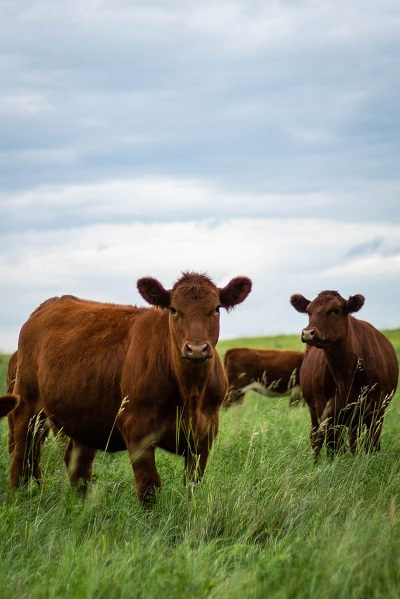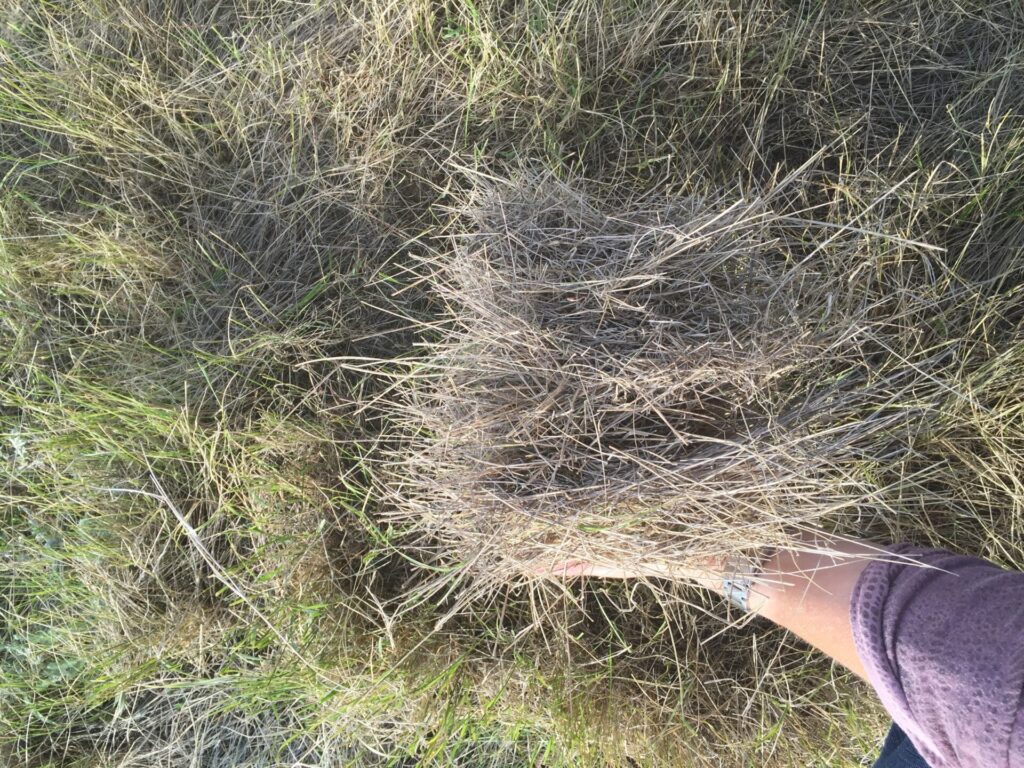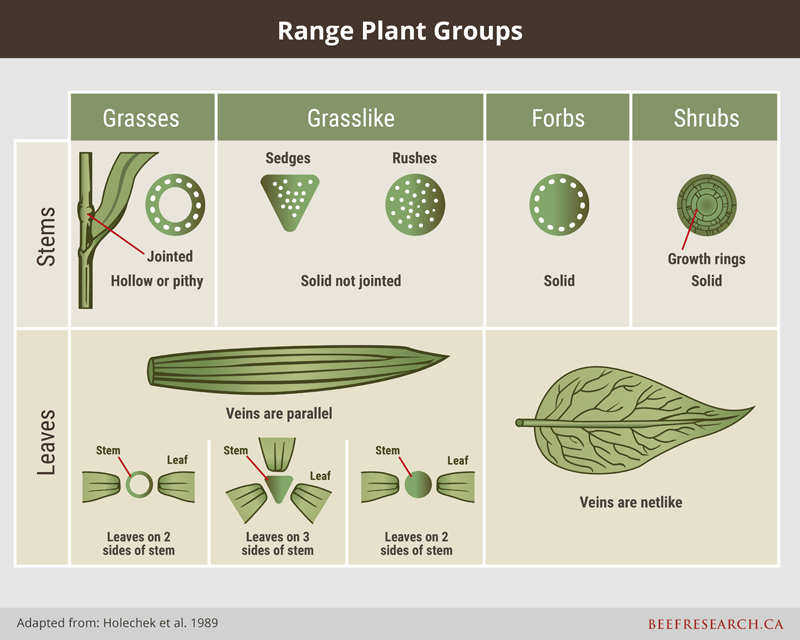
This Level 1 record-keeping module is designed for producers that are new to forage and grasslands record-keeping or who may already keep records but are unsure of what information is worth keeping or how these records can be used.
The goals of good grazing management are to7:
- produce forage for livestock and wildlife
- maintain and protect soil from erosion
- capture and release water
- cycle nutrients and energy
- maintain biological diversity
One of the keys to a successful livestock operation is the proper use of pasture, either native rangeland or tame forages. To properly manage the land, a producer must be familiar with the amount of dry matter forage the pasture can produce and the amount of forage required over the grazing season by each animal and the herd as a whole.
With this knowledge, the proper combination of land, grazing period length, and number of animals can be chosen to ensure the sustained, long-term productivity of the pasture. Having an optimum number of animals on the pasture makes efficient use of the forage without waste, but still leaves enough forage to allow quick and complete recovery.
RANGE HEALTH
The basic principles of grazing management include:
- balance livestock demand with forage supply
- distribute grazing pressure
- provide effective rest periods
- manage livestock most suited to the forage supply and objectives
How do you get started with range health record-keeping?
The following is a recommended list of information to get started in range health record-keeping:
Pasture ID/ Location and Paddock ID: How you identify the location of each pasture, a name anyone working on your operation will recognize.
Acres (or Hectares): The number of acres (hectares) in the pasture identified. One free tool you can use to do this is Google Earth. Click for step-by-step directions on how to use this platform to measure area.
Grass type: Learning to recognize range plants and their role in the ecosystem is key to good range management. Range plants can be grouped based on various characteristics including plant type, season of growth, origin, response to grazing and forage value.
How do you assess rangeland health?

Range health describes how the ecosystem is currently functioning compared to the potential for the site. This method evaluates five indicators including: plant community, structure, litter, site stability and weeds. Range condition compares the current plant community to its potential or “reference” plant community (known as the climax plant community). The four classes of range condition (Excellent, Good, Fair, Poor) explain how the composition of the present plant community has changed from that of the climax community.
Evaluating range health improves upon the original range condition approach by adding indicators, particularly for soil and site conditions, which producers can observe and are easier to measure than plant community alone. Rangeland health assessment tools have been developed to measure how well management principles and practices are being achieved. These assessments better address problems like irreversible changes in range condition and invasion of non-native species.
Assessing rangeland health starts by examining the existing plant community for desirability, diversity and density. Grazing severity, soil erosion, litter residue (dead plant material), disturbance and invasive species/noxious weeds are also taken into account in determining range health.
A sample Grassland Range Health Assessment worksheet is on the BCRC’s rangeland and riparian health page illustrating the evaluation of range health indicators and the steps taken to arrive at a range health score (Healthy = 75-100%; Healthy with Problems = 50-74%; Unhealthy < 50%).
For additional information on evaluating range health by province:
- British Columbia Grazing Management Guide
- Rangeland Health Field Guide (Section 5)
- Alberta Range Health Assessment
- Saskatchewan Range Health Assessment Workbook (2008)
- Manitoba Range and Pasture Health Assessment Workbook (2017)
For more in depth information about the management of tame pastures visit the Pasture 101 modules.
TAME PASTURES
Pasture is a critical resource in the cattle industry. An effective management plan requires clear understanding of forage production, realistic production goals, effective grazing strategies and timely response to forage availability and environmental changes. Visit the BCRC’s grazing management page to learn more about grazing management on pasture.
The Alberta Tame Pasture Scorecard is one tool available that can help you visually assess your tame pasture ranking (low, medium, high) using the following indicators: plant population, plant density, plant vigour, legumes present, weeds and bush present, ground cover, soil damage, nutrient cycling, severity and uniformity of use. Although this is an example from Alberta, the core components are applicable across Canada. Table 2 provides descriptions used in classifying tame pastures (Excellent, Good, Fair or Poor).
Table 2. Tame pasture class definitions
|
|
Excellent |
Good |
Fair |
Poor |
|
Potential yield of the area |
75-100% |
60-75% |
50-60% |
33-50% |
|
Production from desirable, adapted grass and legumes |
95% |
90% |
60% |
Less than 50% |
|
Production from weeds or undesirable plants |
Less than 5% |
Less than 10% |
20% or more |
50% or more |
Source: Alberta Forage Manual (Table 37, page 206) adapted from Wroe et al. (1988) Guide to Range Condition and Stocking Rates for Alberta Grasslands
Watch the BCRC webinar about the basics of developing a grazing plan.
- References
-
- Manglai (2016) Examining Record-Keeping and Benchmarking Effects on the Production and Performance of Cow-calf Farms in Canada.
- Larson, K. (2012). Economics of Cow-calf Production.
- Canfax Research Services (2017). Production & Management Practices that Drive Profitability. Accessed from http://www.canfax.ca/samples/Production%20and%20Management%20Practices%20that%20Drive%20Profitability.pdf
- Focus on Productivity. Canfax Research Services. April 2013. Accessed from http://www.canfax.ca/Samples/Focus%20on%20Productivity%20April%202013.pdf
- Voss, C., Åhlström, P. and Blackmon, K. (1997), “Benchmarking and operational performance: some empirical results“, International Journal of Operations & Production Management, Vol. 17 No. 10, pp. 1046-1058.
- Farm and Dairy (2017) 5 Tips for Setting Farm Goals.
- Alberta Agriculture and Food (2008) The Beef Cow Calf Manual.
- Government of Canada (2019) Keeping Records.
FEEDBACK
Feedback and questions on the content of this page are welcome. Please e-mail us.
Record-Keeping Version 1.0
This content was last reviewed January 2020.


